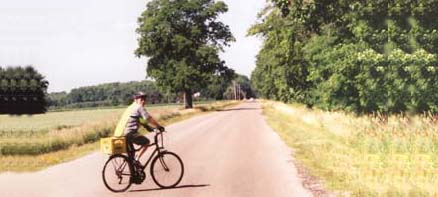 I read my first issue of Plenty Magazine (#15 – The Way We Eat) when, after having moved from
I read my first issue of Plenty Magazine (#15 – The Way We Eat) when, after having moved from  Fittingly the cover image was an update of the familiar 1930 painting of the farmer with pitchfork and wife, American Gothic by Grant Wood. In the 2007 Plenty version the couple, still holding a pitch fork, are young, urban-looking and are now standing in their Toronto-esque, Ikea-style kitchen preparing to harvest wheat, presumably their own crop. An eerie premonition of what will become our own attempts to morph our big city world into a small town lives, and a sign that this quarterly mag might be in the right place at the right time for us.
Fittingly the cover image was an update of the familiar 1930 painting of the farmer with pitchfork and wife, American Gothic by Grant Wood. In the 2007 Plenty version the couple, still holding a pitch fork, are young, urban-looking and are now standing in their Toronto-esque, Ikea-style kitchen preparing to harvest wheat, presumably their own crop. An eerie premonition of what will become our own attempts to morph our big city world into a small town lives, and a sign that this quarterly mag might be in the right place at the right time for us.
In their own words, Plenty is an environmental media company dedicated to giving voice to the green revolution that will define the 21st century. Plenty is about abundance, with hopes that the world will move away from fossil-fuel dependence toward bounty of green energy sources.
 The format is standard for a magazine, with a few significant, eco-type enhancements; it is printed on recycled paper, 80% in the April/May issue and up to 85-100% in the current issue; their carbon footprint (which I actually feel is more about P.R. than good conscience) is 100% offset through Green Mountain Energy; and an electronic copy of each issue is available on-line in it’s entirety for those subscribers who want to completely avoid the whole ink-to-paper process.
The format is standard for a magazine, with a few significant, eco-type enhancements; it is printed on recycled paper, 80% in the April/May issue and up to 85-100% in the current issue; their carbon footprint (which I actually feel is more about P.R. than good conscience) is 100% offset through Green Mountain Energy; and an electronic copy of each issue is available on-line in it’s entirety for those subscribers who want to completely avoid the whole ink-to-paper process.In another positive variation, their advertising, which is significant at just over 20% of the total content, is managed quite differently from the usual “general interest” model. You won’t find any ads within the feature sections; in fact, you can read page after page without interruption. As well, a large percentage of the advertising real-estate is dedicated to conferences, workshops and publications. And I’d have to say I actually read most of the ads.
 The content consists of an unusual, but effective, balance of solid environmental education, with good old fashioned commercialism, which I guess is because as much as we may want to advance ourselves, we still need to buy cereal and go on holiday. This mix might also explain why it’s available at both our national drugstore chain, Shoppers, and our national bookstore chain, Chapters/Coles.
The content consists of an unusual, but effective, balance of solid environmental education, with good old fashioned commercialism, which I guess is because as much as we may want to advance ourselves, we still need to buy cereal and go on holiday. This mix might also explain why it’s available at both our national drugstore chain, Shoppers, and our national bookstore chain, Chapters/Coles. My biggest criticism of Plenty would be that it has a very narrow target market; their ideal reader would have to be equally interested in reading good-sized, solid feature articles about our impact on the world’s natural balance as well as learning about “apres ski indulgences”.
My biggest criticism of Plenty would be that it has a very narrow target market; their ideal reader would have to be equally interested in reading good-sized, solid feature articles about our impact on the world’s natural balance as well as learning about “apres ski indulgences”. I confess many of the features are not interesting enough to hold my attention, and I have been known to skip the odd article about Christmas decorations made from circuit boards, yet I aspire to become the kind of relaxed, patient person who can live harmoniously somewhere between the shallow and the deep; a position that Plenty also seems to be striving for and often reaches.
Quite an achievement for a glossy mag.














































